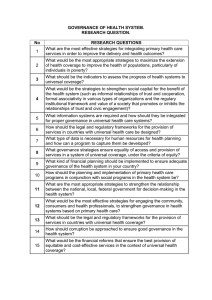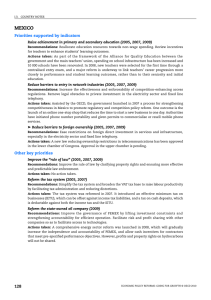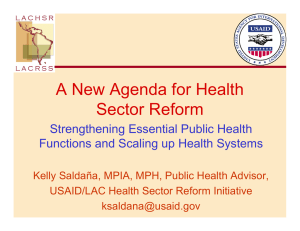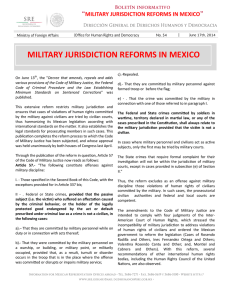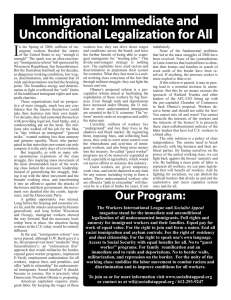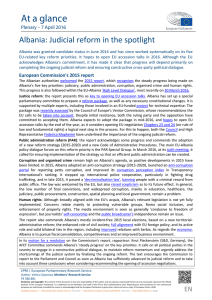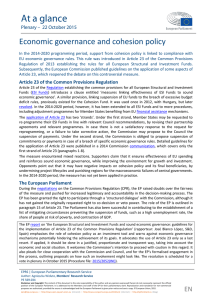PDIA: Building State Capability Through Iterative Adaptation
Anuncio
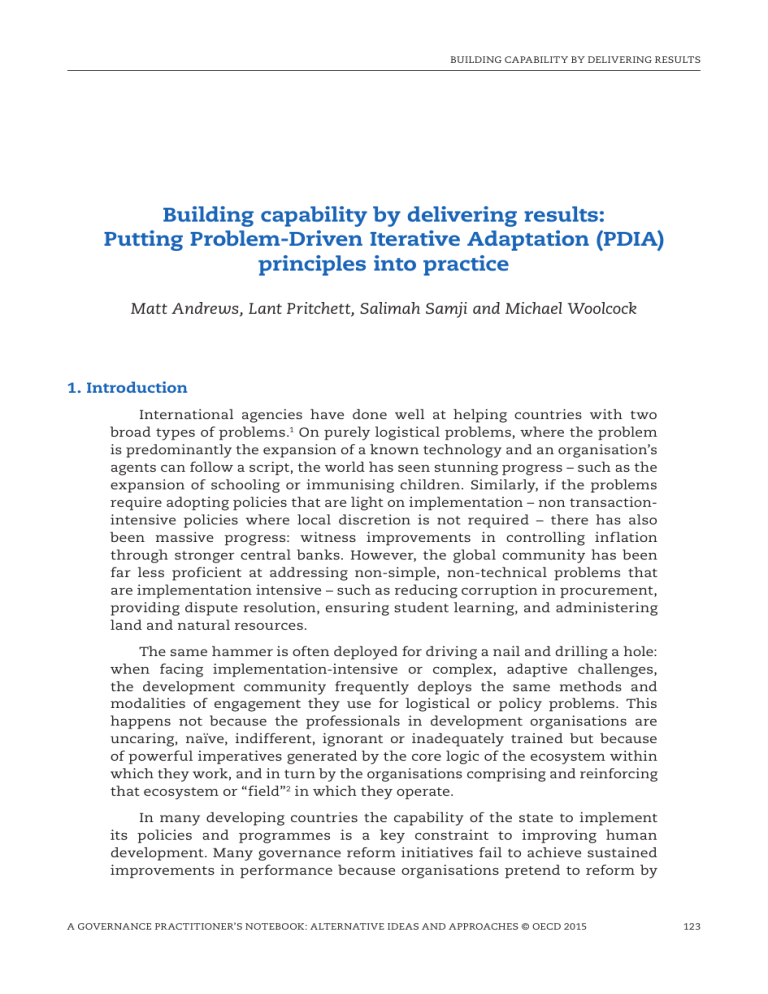
Building capability by delivering results Building capability by delivering results: Putting Problem-Driven Iterative Adaptation (PDIA) principles into practice Matt Andrews, Lant Pritchett, Salimah Samji and Michael Woolcock 1. Introduction International agencies have done well at helping countries with two broad types of problems.1 On purely logistical problems, where the problem is predominantly the expansion of a known technology and an organisation’s agents can follow a script, the world has seen stunning progress – such as the expansion of schooling or immunising children. Similarly, if the problems require adopting policies that are light on implementation – non transactionintensive policies where local discretion is not required – there has also been massive progress: witness improvements in controlling inflation through stronger central banks. However, the global community has been far less proficient at addressing non-simple, non-technical problems that are implementation intensive – such as reducing corruption in procurement, providing dispute resolution, ensuring student learning, and administering land and natural resources. The same hammer is often deployed for driving a nail and drilling a hole: when facing implementation-intensive or complex, adaptive challenges, the development community frequently deploys the same methods and modalities of engagement they use for logistical or policy problems. This happens not because the professionals in development organisations are uncaring, naïve, indifferent, ignorant or inadequately trained but because of powerful imperatives generated by the core logic of the ecosystem within which they work, and in turn by the organisations comprising and reinforcing that ecosystem or “field”2 in which they operate. In many developing countries the capability of the state to implement its policies and programmes is a key constraint to improving human development. Many governance reform initiatives fail to achieve sustained improvements in performance because organisations pretend to reform by A GOVERNANCE PRACTITIONER’S NOTEBOOK: ALTERNATIVE IDEAS AND APPROACHES © OECD 2015 123 Building capability by delivering results changing what policies and organisational structures look like rather than what they actually do. These notional policies allow donor countries (and thus donors themselves) to claim success without actually having achieved any. This process results from a pressure to mimic – when countries face ambiguous goals, are risk averse, uncertain about the means to achieve them and are dependent to varying degrees on external bodies. These external bodies have defined and codified best-practice solutions, which they either implicitly or explicitly compel recipient countries to copy, measuring success by the incidence of such copies (and/or by inputs provided or rules faithfully upheld). We refer to this ability of organisations to sustain legitimacy by imitating the forms of modern institutions without achieving their functionality, as “isomorphic mimicry”. This process can compound upon itself, eventually making failing and flailing states (and the organisations within them) both internally resistant to reform and immune to external pressures for any real change: the more things change the more they stay the same. Donor countries provide bestpractice change scripts and the recipient countries comply, putting on the appearance of change without changing. Such carbon-copy states are then expected to function like real states. They are asked to perform tasks that are too complex and too burdensome, too soon, too often. This external engagement can, paradoxically, actively hinder the emergence of domestic, organically evolved functional organisations, by pushing too hard, so that stresses exceed capability. We call this premature load bearing. How to enhance an organisation’s ability to implement increasingly complex and contentious tasks is a problem whose solution is usually not known or even knowable up front. There are no easy or quick-fix solutions. Building state capability is an idiosyncratic process that looks different in each and every country; the specific institutional structures that come to have local legitimacy and effectiveness are highly dependent on a complex interplay of local context, history, politics and culture. In other words, the wheel must be reinvented, each and every time, because the process by which it emerges (or not) matters more than the product. We argue, as have many others, that solutions to these problems are not to be found in universal bestpractice techniques or generic institutional blueprints. You cannot import or transplant effective, sustainable institutions into any given developing context. In principle, most development professionals will nod in solemn agreement with such sentiments – everyone concurs that recipient countries “should be in the driver’s seat”, that “context matters”, and that “there are no silver bullets” – but in practice this notional consensus is routinely violated; indeed, the imperatives of the aid architecture within which development is conducted essentially require that uniform responses are the norm. 124 A GOVERNANCE PRACTITIONER’S NOTEBOOK: ALTERNATIVE IDEAS AND APPROACHES © OECD 2015 Building capability by delivering results Escaping this trap of stagnant capability and increasing frustration requires new conceptual models of state capability that go beyond transplanting other countries’ institutional blueprints. Our alternative approach, called ProblemDriven Iterative Adaptation (PDIA), offers a framework and a method for the development community to do things differently. It rests on four principles: Local solutions for local problems Transitioning from promoting predetermined solutions to allowing the local nomination, articulation and prioritisation of concrete problems to be solved. Pushing problem-driven positive deviance Creating (and protecting) environments within and across organisations that encourage experimentation and positive deviance. Try, learn, iterate, adapt Promoting active experiential (and experimental) learning with evidence-driven feedback built into regular management that allows for real-time adaptation. Scale through diffusion Engaging champions across sectors and organisations who ensure reforms are viable, legitimate and relevant. The PDIA approach argues that we don’t need more “experts” selling “best practice” solutions in the name of efficiency and the adoption of global standards; we need instead organisations that generate, test and refine context-specific solutions in response to locally nominated and prioritised problems; we need systems that tolerate (even encourage) failure as the necessary price of success. 2. Construct locally driven problems PDIA is about building capability through the process of solving good problems. It’s not about finding the solution and then replicating that solution; it places emphasis on the process of solving problems, not the solutions themselves. Historically, this is how today’s most effective organisations acquired and now maintain their capability for implementation. It is not easy or without real risk but ultimately it is a more sustainable approach because it infuses legitimacy into change processes that inherently generate a contentious mix of “winners” and “losers”. Problems are key to driving change. Change usually happens if the following conditions exist: • There is disruption in the context (i.e. something is recognised to be going wrong, because of a crisis or some disruption to the status quo). • Those who need to change are willing to question the way they do things (i.e. the incumbents are weakened). A GOVERNANCE PRACTITIONER’S NOTEBOOK: ALTERNATIVE IDEAS AND APPROACHES © OECD 2015 125 Building capability by delivering results • There is an active search for a real and legitimate “new” alternative (i.e. for something that can be done and will be fit to context). • The power of agency is mobilised around the new approach instead of the old ways. Most development practitioners think their work is already structured around problems. However, their problems are often identified and constructed from the top down or are determined by external experts. In addition, when asked to name a problem, they often name the lack of a solution (e.g. you don’t have a procurement system). This leads to standardised interventions, which don’t address the actual problem.3 Put differently, such approaches place development professionals in the business of selling solutions they happen to have rather than working with counterparts to craft solutions to specific problems that counterparts themselves have identified and prioritised. The most vexing problems in the public sector are “wicked hard” – they are simultaneously logistically complex, politically contentious (i.e. implementing them generates potentially hostile resistance), have no known solution prior to starting, and contain numerous opportunities for professional discretion. Often, such meta problems need to be broken down into smaller and more manageable problems around which support can be mobilised and ultimately solved.4 One needs to have mechanisms to identify problems, to construct and deconstruct the problems, to refine the problem based on emerging experience, and to ensure that the problem provides some aspirational goal for action and plausible entry points to start executing change. A good problem therefore, is one that is locally driven, where local actors define, debate and refine the problem statement through shared consensus. In reality, the process of problem identification is likely to be long, iterative and uncertain – much longer and more uncertain than most of today’s development agencies are set up to accommodate. We believe that constructing local problems is the entry point to beginning the search for solutions that ultimately drive change.5 A problem that matters is one that gets attention and mobilises action. Such action requires coalitions – groups of agents mobilised to work together to solve common problems that they cannot solve on their own. A clear problem can become the basis for an honest and directed search for legitimate and contextually relevant solutions. The process of problem identification is a long iterative process of diagnosing, testing and revising; the learning thus needs to be experiential, occurring in real time, with built-in rapid cycles feeding back into design and implementation. It requires taking calculated risks, embracing politics and being adaptable (thinking strategically but building on flexibility). Crucially, one needs the humility to accept that we do not have the answers and to accept, discuss and learn from failure. 126 A GOVERNANCE PRACTITIONER’S NOTEBOOK: ALTERNATIVE IDEAS AND APPROACHES © OECD 2015 Building capability by delivering results 3. Build and maintain authorisation An impact evaluation assumes that outputs are a given and tests whether outputs lead to outcomes. In reality, however, the key outputs required often do not materialise and therefore outcomes are not achieved; more importantly, there is no learning about where, how and why the failure occurred in the process of going from inputs to outputs to outcomes. The iterative learning process in PDIA helps ensure that inputs are being translated into activities, which in turn are leading to outputs. To put PDIA into practice, it requires that agents receive authorisation to do things that, in their current ecosystem, they are not allowed to do. It requires changes in an organisation’s authorising mechanisms and personnel structure to authorise a reform, to incubate it, and then to get it moving. How does one gain and secure robust authorisation? This brings us to the topic of leadership, a topic that is often overlooked in development, or addressed is superficial ways. Given a specific development project, who – notionally and actually – leads the reform process? On what basis is that person identified as a leader? Do they have access to adequate resources? To top-down authority? Implementing power? Rather than the traditional view of leadership – whereby development projects seek to gain authorisation through an individual champion, who is sufficiently high ranking to help push through a proposed reform – we argue that reforms are never really led by one person alone. Indeed, this “hero orthodoxy” can actually be another source of failure in development. Successful change comes instead through multi-agent leadership. In this view, the cumulative and concerted efforts of a networked team (rather than any one leader alone) result in success. If the right people needed to make a reform succeed are not initially engaged together, how can we get authorisation across multiple domains? Potential collaborators might come from different sectors/levels/agencies within a government, they might have different individual capacities, they might not have even met each other. In a case of legal reform, for example, change might require authorisers from the Ministry of Justice and also the local court systems, which each have their own completely different authorising environments. How do these authorisers get together? In such cases, collaborators/coalitions are helpful in making effective teams that can push reforms and create spaces for authorisation. We do not believe that building the state’s capability for implementation – or development in general – happens exclusively or even predominantly from the top down. We hold, rather, that change primarily takes root when it involves broad sets of agents engaged together in designing and implementing locally relevant solutions to locally nominated and prioritised problems. PDIA is about building and sustaining broad coalitions of stakeholders, at both the political and implementation level, working toward a shared goal. You do not A GOVERNANCE PRACTITIONER’S NOTEBOOK: ALTERNATIVE IDEAS AND APPROACHES © OECD 2015 127 Building capability by delivering results just have to maintain the initial authorisation, but also expand the number of actors who provide authorisation, thus building momentum and increasing the legitimacy of the project or reform.6 We call this “building capability by delivering results”. 4. Learn, iterate and adapt Figure 1 shows how the PDIA process works, through a series of six-stage “find and fit” iterations that are intended to foster the gradual but progressive identification and implementation of reforms that help governments escape the capability trap. Figure 1. A six-stage “find and fit” iteration within the PDIA approach 3. Action is taken; members of the group are encouraged to take action and held accountable for their steps 2. Initial action steps are identified by the group (what can we do first/next to start solving the problem?) 1. Locally felt problem is constructed, with clear idea of what “problem solved” will look like: An entry point for action is identified; a group of local agents is gathered to work on this problem. 4. The group takes stock of experience; what results were achieved? What lessons were learned? What challenges were encountered? How did we overcome the challenges? 5. Using evidence from the stock-take, group communicates quick wins and lessons to bolster legitimacy and authority, expand support 6. Key question: Did the prior iteration solve the problem? 6.ii. If yes, exit the process and think about diffusion or scaling challenge. 6.ii. If no, build on expanded authority, use lessons to adapt thinking about the problem and potential solution designs, and iterate again Figure 2 illustrates how PDIA achieves this kind of gradual functional improvement with growing legitimacy. Step 1.1 captures Stages 1 to 3 in the discussion above, where reform groups identify and implement actions they have identified as important in solving a particular problem. This step helps the group learn about enhancing state capability and functionality. Step 1.2 consolidates Stages 4 and 5, where reform groups use information from the earlier stages to consolidate and build legitimacy and support for the reform. At this point, the reform group has not identified a final solution but has progressed somewhat in this direction. It has learned what is needed to fit those parts of the solution that have been identified to the context and it has ensured that there is support for the step that has been taken – and authority to take another step (2.1). As the group iterates through these stages 128 A GOVERNANCE PRACTITIONER’S NOTEBOOK: ALTERNATIVE IDEAS AND APPROACHES © OECD 2015 Building capability by delivering results in repeated iterations (Steps 2 and 3), it finds and fits more dimensions of the solution to the context. Gradually, this leads to an end point where the problem is solved. Figure 2. Iterating to meet the dual challenge of legitimacy and functionality in reform Enhanced legitimacy and support 3.2 3.1 B: The Goal: problem solved 2.2 A: The starting point: a felt problem 1.2 2.1 1.1 Enhanced functionality Figure 3. Putting PDIA to work in Mozambique 2000-2007 Major demand on Mozambique’s judicial sector. Insufficient and disorganised supply. 2007-2012 Donors support multi-million dollar project to build case management system to improve management in sector. 2012 Project monies have been disbursed; no system exists and Mozambique’s judicial sector is still poorly managed. There is no co-ordinated availability of data to make decisions, make budgets or manage resources. PDIA in Mozambique 1. Getting Authorisation to Start First question: What problem do you need solved, Madam Minister? Second question: Will you authorise work with a team in the sector? Starting small, building authority, results over time. Problem prob·lem noun 1. A matter or situation regarded as unwelcome or harmful and needing to be dealt with and overcome. 2. Building team of local people, all with broader connections into sector: What is the problem? How do we construct it (to gain attention)? How do we deconstruct it (to find entry points for action)? Where do we start looking for solutions? 2013 Minister of Justice asks for help. 3. Take action; try, learn, iterate, adapt For six months… running into capacity constraints, political tensions and other roadblocks that stopped past projects. But this time the team was iterating, so they could work around and through the challenges. 4. After six months Cross-sectoral team has an Excel spreadsheet full of data about sector, can use this in budget process. Not a formal “system” but a functional hybrid. A GOVERNANCE PRACTITIONER’S NOTEBOOK: ALTERNATIVE IDEAS AND APPROACHES © OECD 2015 129 Building capability by delivering results To summarise, PDIA focuses on solving locally nominated and defined problems in performance (as opposed to transplanting pre-conceived and packaged “best practice” solutions). It seeks to create an authorising environment for decision making that encourages positive deviance7 and experimentation (as opposed to designing projects and programmes and then requiring agents to implement them exactly as designed). It embeds this experimentation in tight feedback loops that facilitate rapid experiential learning (as opposed to enduring long lag times in learning from evaluation after the fact). It actively engages broad sets of agents to ensure that reforms are viable, legitimate, relevant and supportable (as opposed to a narrow set of external experts promoting the top-down diffusion of innovation). In Mozambique, a PDIA approach to judicial reform has followed this sequence (see Figure 3).8 The PDIA approach has many intellectual forebears and contemporaries.9 We situate PDIA within this ever-evolving intellectual landscape alongside related work by academic researchers, business thinkers and development practitioners, identifying the similarities and differences between these approaches. While PDIA shares many similarities with – indeed, actively borrows from – many aspects of this recent (and not-so-recent) literature, it is in fact quite different. PDIA aspires to provide a fully comprehensive framework, one that integrates the strengths and builds on the weaknesses revealed by antecedent approaches. We aim to provide a set of principles and approaches together with an array of techniques for coping with each of the concrete steps: problem definition, creating authorised space for novelty and positive deviation, feedback and iteration, and scaling achieved by diffusing new ideas and strategies through an expanding community of practice. 4. Conclusion: PDIA-ing PDIA Across the world, historically unprecedented gains have been achieved in development over the last fifty years. Much of this has happened, however, through the decline of awful things (large-scale wars, famines, pandemics, everyday violence), the advent of more pro-development policy reforms overseen by technocratic elites (trade openness, fiscal stability) and the introduction of services, or aspects of services, amendable to implementation via a minimally comprehensive logistics apparatus (building schools, printing textbooks, immunising babies).10 As difficult and important as these achievements have been, that was the easy part; as development succeeds it only gets harder, because the scale and complexity of the organisational tasks required to sustain and advance a modern economy, society, polity and public administration intensifies. Land administration, pension systems, food safety, progressive taxation, business regulation, public health, environmental management, energy infrastructure, transport systems… All of these and 130 A GOVERNANCE PRACTITIONER’S NOTEBOOK: ALTERNATIVE IDEAS AND APPROACHES © OECD 2015 Building capability by delivering results more are, or become, central tasks of middle-income countries, and their effective implementation necessarily requires a highly capable state. Our prevailing aid architecture is inadequately situated to engage with these challenges, but engage with them we must: historical events, geopolitical realities, the advocacy of social movements, broader shifts in public sentiment regarding the importance of human rights and reducing corruption, and (most importantly) the demands of developing countries themselves have combined to put these challenges front and centre of the 21st century development agenda. Instead of asking an aid architecture strong on logistics and policy reform to take on the qualitatively different challenges of building institutional capability, which are deeply complex and contentious, we need a complementary, customised and customisable architecture that is fit for purpose. Instead of forcing square pegs into round holes, we need strategies for responding to development pegs of all shapes and sizes. PDIA is one attempt to respond to this challenge. To move PDIA – or strategies broadly similar to it – from the margins to a more central place in development strategy, however, will clearly require more than clarion calls, some publications, a few training programmes or high-energy conferences. It will take a global social movement of development professionals who are willing and able to create (and protect) space within their own organisations for “doing development differently”11 and who can integrate their experiences with those of others. It will take putting into practice the principles we have outlined here as they seek to instantiate and then expand this movement, whose credibility will ultimately turn on being able to demonstrate, most especially to colleagues, clients and counterparts, that a superior alternative to orthodoxy is not only think-able and say-able but do-able. These processes are now underway – in justice reform in Mozambique and Cambodia, in service delivery reform in Albania and Indonesia, in civil service reform in Sierra Leone – and are being deployed by a range of development agencies, even as much surely remains to be done. It is a challenge to which we invite readers to contribute as this movement itself collectively learns to iterate, learn, improve and expand. Notes 1. This chapter summarises more detailed findings and arguments in Andrews (2013a); Pritchett, Woolcock and Andrews (2013); and Andrews, Pritchett and Woolcock (2013). Access to the various publications and resources associated with this work can be found at the Building State Capability programme (based at Harvard University’s Center for International Development); see http://bsc.cid.harvard.edu/. 2. The concept of an organisational “field” comes from Bourdeiu (1993). 3. Watch the Building State Capability (BSC) video, “Selling solutions vs. solving problems” (http://vimeo.com/92338009). A GOVERNANCE PRACTITIONER’S NOTEBOOK: ALTERNATIVE IDEAS AND APPROACHES © OECD 2015 131 Building capability by delivering results 4. Watch the BSC video, “Deconstructing sticky problems” (http://vimeo.com/91733930). 5. Watch the BSC video, “Real problem driven reform” (http://vimeo.com/91733932). 6. Watch the BSC video, “Maintaining your authorizing environment” (http://vimeo. com/84691288). 7. The idea of learning from “positive deviance” is most forcefully articulated in Pascale, Sternin and Sternin (2010). See also Andrews (2013b). 8. For details on the Mozambique case, see Andrews (2014). 9. See, for example, Lindblom (1959). 10. See Pinker (2011), Deaton (2013) and Kenny (2012). 11. See this movement’s “manifesto” and strategy agenda at: http://doingdevelopmentdifferently. com/. Bibliography Adler, D., C. Sage and M. Woolcock (2009), “Interim institutions and the development process: Opening spaces for reform in Cambodia and Indonesia”, BWPI Working Paper, No. 86, Brooks World Poverty Institute, University of Manchester. Andrews, M. (2014), “Can one retell a Mozambican reform story through problem driven iterative adaptation?”, Faculty Research Working Paper Series, RWP14-018, Harvard Kennedy School, Harvard. Andrews, M. (2013a), The Limits of Institutional Reform in Development: Changing Rules for Realistic Solutions, Cambridge University Press, New York. Andrews, M. (2013b), “How do governments get great?”, Faculty Research Working Paper Series, RWP13-020, Harvard Kennedy School, Harvard. Andrews, M. (2013c), “Explaining positive deviance in public sector reform in development”, Faculty Research Working Paper Series, RWP13-040, Harvard Kennedy School, Harvard. Andrews, M., J. McConnell and A. Wescott (2010), Development as Leadership-Led Change: A Report for the Global Leadership Initiative, World Bank, Washington, DC. Andrews, M., L. Pritchett, and M. Woolcock (2013), “Escaping capability traps through Problem Driven Iterative Adaptation (PDIA)”, World Development, Vol. 51(11), pp. 234-44. Booth, D. (2013), Facilitating Development: An Arm’s Length Approach to Aid, Politics and Governance, ODI (Overseas Development Institute), London. Booth, D. (2011), “Working with the grain and swimming against the tide: Barriers to uptake of research findings on governance and public services in low-income Africa”, Africa Power and Politics Working Paper, No. 18, ODI, London. Bourdeiu, P. (1993), The Field of Cultural Production: Essays on Art and Literature, Polity Press, Cambridge, UK. Deaton, A. (2013), The Great Escape: Health, Wealth and the Origins of Inequality, Princeton University Press, Princeton, NJ. Kenny, C. (2012), Getting Better: Why Global Development is Succeeding—And How We Can Improve the World Even More, Basic Books, New York. Levy, B. and F. Fukuyama. (2010), “Development strategies: Integrating governance and growth”, Policy Research Working Paper, No. 5196, World Bank, Washington, DC. 132 A GOVERNANCE PRACTITIONER’S NOTEBOOK: ALTERNATIVE IDEAS AND APPROACHES © OECD 2015 Building capability by delivering results Levy, B. (2014), Working with the Grain: Integrating Governance and Growth in Development Strategies, Oxford University Press, New York. Lindblom, C. (1959), “The science of ‘muddling through’”, Public Administration Review, Vol.19(2) pp. 79-88. Moore, M. (1995), Creating Public Value: Strategic Management in Government, Harvard University Press, Cambridge, MA. Pascale, R., J. Sternin and M. Sternin (2010), The Power of Positive Deviance: How Unlikely Innovators Solve the World’s Toughest Problems, Harvard Business Review Press. Pinker, S. (2011), The Better Angels of our Nature: Why Violence Has Declined, Penguin, New York. Pritchett, L. (2009), “Is India a flailing state? Detours on the four lane highway to modernization”, Faculty Research Working Paper Series, RWP09-013, Harvard Kennedy School, Harvard. Pritchett, L., S. Samji and J. Hammer (2013), “It’s all about MeE: Using structured experiential learning (‘e’) to crawl the design space”, Working Paper, No. 322, Center for Global Development. Pritchett, L., and M. Woolcock (2004), “Solutions when the solution is the problem: Arraying the disarray in development”, World Development, Vol 32(2) pp. 191-212. Pritchett, L., M. Woolcock and M. Andrews (2013), “Looking like a state: Techniques of persistent failure in state capability for implementation”, Journal of Development Studies, Vol. 49(1) pp. 1-18. A GOVERNANCE PRACTITIONER’S NOTEBOOK: ALTERNATIVE IDEAS AND APPROACHES © OECD 2015 133
